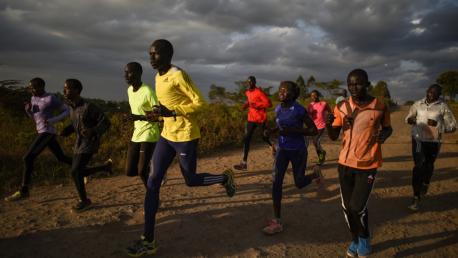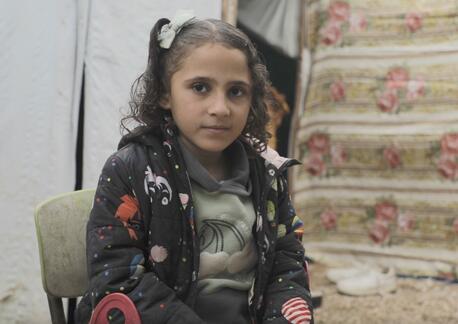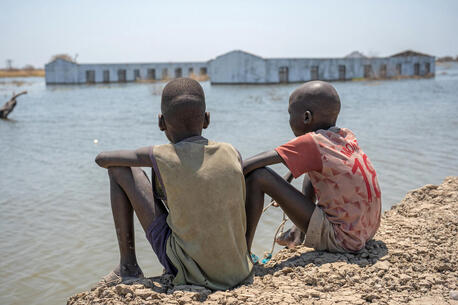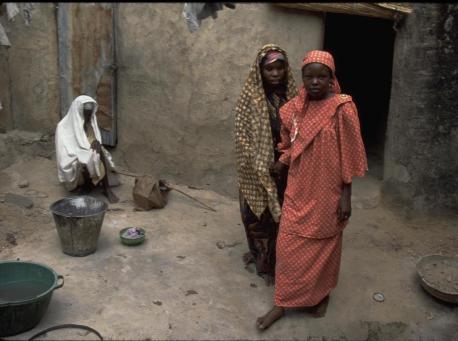
Refugee Olympic Team: The Refugee Runners of South Sudan
Refugee Olympic Team members Yiech Pur Biel, James Nyang Chiengjiek, Rose Nathike Lokonyen, Paulo Amotun Lokoro and Anjelina Nadai Lohalith all fled civil war in South Sudan as children. Often alone, they crossed vast areas, dodging harm at every step until finally reaching the safe haven of Kakuma Refugee Camp in Kenya. Most of them have lived the majority of their lives in Kakuma. Selected to join a team of Olympians, they trained every day for months in Kenya before embarking on the Road to Rio.
Watch their stories:
Fleeing a fierce civil war, Biel journeyed from his hometown of Nasir, South Sudan to the Kakuma Refugee Camp in Kenya on his own in 2005. After living in a refugee camp for ten years, he started running competitively just over a year ago. Biel was determined to grab his opportunity to represent the world’s refugees on such a grand stage as the Rio 2016 Olympic Games. “Even if I don’t get gold or silver, I will show the world that, as a refugee, you can do something,” he said.
James Nyang Chiengjiek was 13 when he fled his home in South Sudan to avoid being kidnapped by rebels who were forcibly recruiting child soldiers. The highland region of Chiengjiek’s camp is known for its long-distance runners. At school he started training with the older students, and his talent was soon noticed. “That’s when I realized I could make it as a runner — and if God gives you a talent, you have to use it.” Fifteen years later, Chiengjiek is competing in the 400m at the Rio Olympics.
Until about a year ago, South Sudanese refugee Rose Nathike Lokonyen ran barefoot through the refugee camp she called home. When Lokonyen was ten, she and her family fled from southern Sudan to escape the outbreak of conflict and violence, part of a mass exodus that has persisted for decades. Now 23, Lokonyen has spent the years since then in the giant Kakuma refugee camp in northern Kenya, home to about 180,000 displaced people. At the Rio Olympics, she is running in the 800m.
In 2004, the outbreak of violence in southern Sudan caused Lokoro’s parents to flee to neighbouring Kenya. “The war started, so we ran away," Lokoro remembers. "We ran to the bush and stayed in the bush. There was no food, we just ate fruit.” Going to school in Kakuma, Lokoro excelled in sports, especially running. He won many races during his teenage years. In 2015, professional coaches from the Tegla Loroupe Foundation arrived in Kakuma to hold athletics scouting trials. Lokoro participated and excelled, earning himself a place at the athletics foundation based in Nairobi, where he has trained for the Rio 2016 Olympics.
In 2001, Lohalith had to leave her home when her country was gripped by civil war and violence closed in on her village. “Everything was destroyed” says Lohalith, who is just one of the many thousands of children displaced or orphaned because of fighting in the country. “Since I came from there to here, I have never communicated with them,” Anjelina Nadai Lohalith said about her parents, who she last saw when she fled the war in South Sudan at age six. Lohalith arrived in northern Kenya in 2002, settling in the Kakuma refugee camp, where she has spent the majority of her life. While attending primary school in the camp, she took up running, a sport in which she naturally excelled.
The Refugee Olympic Team represents the key crisis of our time: that of refugees and the displaced. At a time when more than 65 million people are displaced, many of them children, the participation of the team in Rio sends a powerful signal of hope to refugees around the world. Further, the team aims to promote unity among refugees of various backgrounds and overcome divisions with host communities.
According to a report by the UN Refugee Agency, on average 24 people were forced to flee each minute in 2015 — four times more than a decade earlier. Shockingly, children made up about half of the refugee population in 2015, up from 41 per cent in 2009. In the first six months of 2016 alone, 73,000 children arrived in Europe by way of a sea crossing that has been deadly for too many. Nearly 100,000 child refugees were separated from their parents or traveled alone. And for a growing number, there is nowhere to go.
Read more about Refugee Olympic Team Member Yiech Pur Biel.
Read the story of Refugee Olympic Team member Yusra Mardini.
Read the story of Refugee Olympic Team Member Rami Anis.
HOW TO HELP
There are many ways to make a difference
War, famine, poverty, natural disasters — threats to the world's children keep coming. But UNICEF won't stop working to keep children healthy and safe.
UNICEF works in over 190 countries and territories — more places than any other children's organization. UNICEF has the world's largest humanitarian warehouse and, when disaster strikes, can get supplies almost anywhere within 72 hours. Constantly innovating, always advocating for a better world for children, UNICEF works to ensure that every child can grow up healthy, educated, protected and respected.
Would you like to help give all children the opportunity to reach their full potential? There are many ways to get involved.





